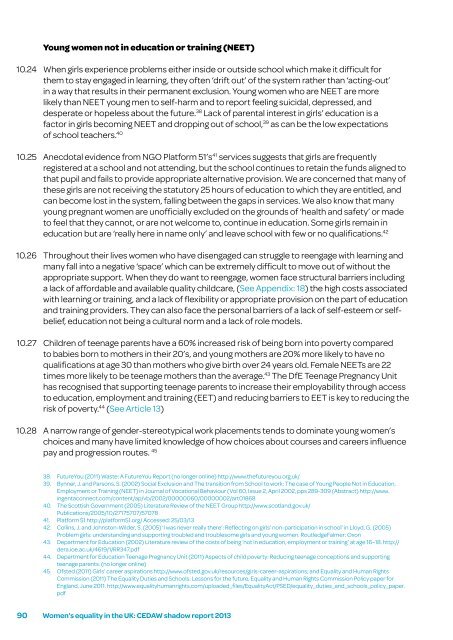Women’s equality in the UK – A health check
Women’s equality in the UK – A health check
Women’s equality in the UK – A health check
You also want an ePaper? Increase the reach of your titles
YUMPU automatically turns print PDFs into web optimized ePapers that Google loves.
10.24<br />
10.25<br />
10.26<br />
10.27<br />
10.28<br />
Young women not <strong>in</strong> education or tra<strong>in</strong><strong>in</strong>g (NEET)<br />
When girls experience problems ei<strong>the</strong>r <strong>in</strong>side or outside school which make it difficult for<br />
<strong>the</strong>m to stay engaged <strong>in</strong> learn<strong>in</strong>g, <strong>the</strong>y often ‘drift out’ of <strong>the</strong> system ra<strong>the</strong>r than ‘act<strong>in</strong>g-out’<br />
<strong>in</strong> a way that results <strong>in</strong> <strong>the</strong>ir permanent exclusion. Young women who are NEET are more<br />
likely than NEET young men to self-harm and to report feel<strong>in</strong>g suicidal, depressed, and<br />
desperate or hopeless about <strong>the</strong> future. 38 Lack of parental <strong>in</strong>terest <strong>in</strong> girls’ education is a<br />
factor <strong>in</strong> girls becom<strong>in</strong>g NEET and dropp<strong>in</strong>g out of school, 39 as can be <strong>the</strong> low expectations<br />
of school teachers. 40<br />
Anecdotal evidence from NGO Platform 51’s 41 services suggests that girls are frequently<br />
registered at a school and not attend<strong>in</strong>g, but <strong>the</strong> school cont<strong>in</strong>ues to reta<strong>in</strong> <strong>the</strong> funds aligned to<br />
that pupil and fails to provide appropriate alternative provision. We are concerned that many of<br />
<strong>the</strong>se girls are not receiv<strong>in</strong>g <strong>the</strong> statutory 25 hours of education to which <strong>the</strong>y are entitled, and<br />
can become lost <strong>in</strong> <strong>the</strong> system, fall<strong>in</strong>g between <strong>the</strong> gaps <strong>in</strong> services. We also know that many<br />
young pregnant women are unofficially excluded on <strong>the</strong> grounds of ‘<strong>health</strong> and safety’ or made<br />
to feel that <strong>the</strong>y cannot, or are not welcome to, cont<strong>in</strong>ue <strong>in</strong> education. Some girls rema<strong>in</strong> <strong>in</strong><br />
education but are ‘really here <strong>in</strong> name only’ and leave school with few or no qualifications. 42<br />
Throughout <strong>the</strong>ir lives women who have disengaged can struggle to reengage with learn<strong>in</strong>g and<br />
many fall <strong>in</strong>to a negative ‘space’ which can be extremely difficult to move out of without <strong>the</strong><br />
appropriate support. When <strong>the</strong>y do want to reengage, women face structural barriers <strong>in</strong>clud<strong>in</strong>g<br />
a lack of affordable and available quality childcare, (See Appendix: 18) <strong>the</strong> high costs associated<br />
with learn<strong>in</strong>g or tra<strong>in</strong><strong>in</strong>g, and a lack of flexibility or appropriate provision on <strong>the</strong> part of education<br />
and tra<strong>in</strong><strong>in</strong>g providers. They can also face <strong>the</strong> personal barriers of a lack of self-esteem or selfbelief,<br />
education not be<strong>in</strong>g a cultural norm and a lack of role models.<br />
Children of teenage parents have a 60% <strong>in</strong>creased risk of be<strong>in</strong>g born <strong>in</strong>to poverty compared<br />
to babies born to mo<strong>the</strong>rs <strong>in</strong> <strong>the</strong>ir 20’s, and young mo<strong>the</strong>rs are 20% more likely to have no<br />
qualifications at age 30 than mo<strong>the</strong>rs who give birth over 24 years old. Female NEETs are 22<br />
times more likely to be teenage mo<strong>the</strong>rs than <strong>the</strong> average. 43 The DfE Teenage Pregnancy Unit<br />
has recognised that support<strong>in</strong>g teenage parents to <strong>in</strong>crease <strong>the</strong>ir employability through access<br />
to education, employment and tra<strong>in</strong><strong>in</strong>g (EET) and reduc<strong>in</strong>g barriers to EET is key to reduc<strong>in</strong>g <strong>the</strong><br />
risk of poverty. 44 (See Article 13)<br />
A narrow range of gender-stereotypical work placements tends to dom<strong>in</strong>ate young women’s<br />
choices and many have limited knowledge of how choices about courses and careers <strong>in</strong>fluence<br />
pay and progression routes. 45<br />
38. FutureYou (2011) Waste: A FutureYou Report (no longer onl<strong>in</strong>e) http://www.<strong>the</strong>futureyou.org.uk/<br />
39. Bynner, J. and Parsons, S. (2002) Social Exclusion and The transition from School to work: The case of Young People Not <strong>in</strong> Education,<br />
Employment or Tra<strong>in</strong><strong>in</strong>g (NEET) <strong>in</strong> Journal of Vocational Behaviour (Vol 60, Issue 2, April 2002, pps 289-309 (Abstract) http://www.<br />
<strong>in</strong>gentaconnect.com/content/ap/vb/2002/00000060/00000002/art01868<br />
40. The Scottish Government (2005) Literature Review of <strong>the</strong> NEET Group http://www.scotland.gov.uk/<br />
Publications/2005/10/27175707/57078<br />
41. Platform 51 http://platform51.org/ Accessed: 25/03/13<br />
42. Coll<strong>in</strong>s, J. and Johnston-Wilder, S. (2005) ‘I was never really <strong>the</strong>re’: Reflect<strong>in</strong>g on girls’ non-participation <strong>in</strong> school’ <strong>in</strong> Lloyd, G. (2005)<br />
Problem girls: understand<strong>in</strong>g and support<strong>in</strong>g troubled and troublesome girls and young women. RoutledgeFalmer: Oxon<br />
43. Department for Education (2002) Literature review of <strong>the</strong> costs of be<strong>in</strong>g ‘not <strong>in</strong> education, employment or tra<strong>in</strong><strong>in</strong>g’ at age 16<strong>–</strong>18. http://<br />
dera.ioe.ac.uk/4619/1/RR347.pdf<br />
44. Department for Education Teenage Pregnancy Unit (2011) Aspects of child poverty: Reduc<strong>in</strong>g teenage conceptions and support<strong>in</strong>g<br />
teenage parents. (no longer onl<strong>in</strong>e)<br />
45. Ofsted (2011) Girls’ career aspirations http://www.ofsted.gov.uk/resources/girls-career-aspirations; and Equality and Human Rights<br />
Commission (2011) The Equality Duties and Schools: Lessons for <strong>the</strong> future, Equality and Human Rights Commission Policy paper for<br />
England, June 2011. http://www.<strong>equality</strong>humanrights.com/uploaded_files/EqualityAct/PSED/<strong>equality</strong>_duties_and_schools_policy_paper.<br />
pdf<br />
90 <strong>Women’s</strong> <strong>equality</strong> <strong>in</strong> <strong>the</strong> <strong>UK</strong>: CEDAW shadow report 2013


